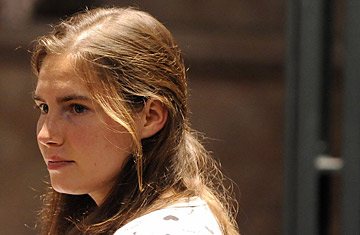
Amanda Knox at her trial in a courthouse in Perugia, Italy, on Nov. 30, 2009
Lawyers in Italy have now fired their best shots at Amanda Knox, the Seattle exchange student accused of killing her British roommate, explaining the murder of Meredith Kercher in terms of saint vs. sinner. In final arguments, Perugia's public prosecutor Giuliano Mignini said the American slit her roommate's throat on the night of Nov. 1, 2007, driven by sexual desire and alpha-female competitiveness. Asking for a life sentence with nine months' isolation, Mignini said "La Knox" wanted a sex "game" and used her feminine wiles to manipulate two besotted young men — one of whom is already convicted, the other on trial with her — into restraining Kercher while she plunged a kitchen knife into her neck.
"Probably she would have insulted Meredith," Mignini said, reconstructing the event with representatives of the U.S. embassy seated silently a few feet behind the defense table. "And she probably said, 'You are always behaving like a little saint. Now we will show you, and now we will make you have sex!'"
Elaborating the saint-sinner theme later, an Italian civil lawyer arguing for millions in damages against the American called Knox a "Luciferina ... dirty in her soul," who is "beautiful in her looks but also sly and intelligent. Is she the good-looking, charming, clean white face we see here today? Keep in mind that the girl we see is a girl that has been changed by two years in prison."
As he spoke, Knox, whose compulsive journal-writing in the early days of her incarceration inadvertently provided authorities and media 300 pages of a "prison diary" to examine for clues to her mentality, scribbled on a legal pad, "In prison, you do not become a beautiful person unless you have an inner light that guides you." Italian photographers captured her note-to-self.
The third person involved, Rudy Guede, left a mountain of physical evidence including fingerprints, footprints and DNA on Kercher's body, but the material evidence against Knox and boyfriend Raffaele Sollecito consists of just two elements: a microscopic speck of Sollecito's DNA on a bra clasp that was apparently sliced off Kercher's back during the attack and another speck of biological substance compatible with Kercher on a kitchen knife picked by police at random from Sollecito's drawers after his arrest, with Knox's DNA on the handle. Prosecutors say the two college students spent a sleepless night at the crime scene scrubbing away their tracks.
As for Knox's defenders, since the early days in the case, American lawyers and experts have criticized the evidence. New to that chorus is Greg Hampikian, chief of the Idaho branch of the Innocence Project, who released a report to TIME saying the knife and bra clasp evidence against Knox are meaningless under prevailing standards in U.S. courts. Kercher's bra clasp, discovered at the scene of the murder six weeks later and revealed to the press the morning after a defense expert demolished other material evidence on a national television show, "cannot reliably be interpreted to show that Sollecito's DNA was on the bra clasp at the time of the murder" and therefore "does not constitute credible evidence," Hampikian wrote.
As for the kitchen knife, Hampikian said the amount of biological material on it was so tiny that it was consumed in one test and cannot be retested — a prerequisite for evidence in U.S. courts — suggesting its presence was due to contamination from previous tests involving Kercher's DNA in the highly sensitive machines.
The defense has already presented similar arguments from Italian experts, but they have never been able to erase what remains the most critical piece of evidence against Knox: her own words. During police questioning four days after the murder, she broke down in tears and said she thought she might have been inside the house listening to her friend's final screams. She also falsely accused her boss, a bar owner, of the killing. She wrote that version of events down after first describing it but has since said she invented it after police physically and verbally abused her. The Italian prosecutor filed defamation charges against her family last week for making the same claim.
For Americans since Nathaniel Hawthorne, Perugia has been a disorienting place, with steep, winding alleys leading to brick dead ends or unexpected sky and mountain vistas. Guilty or not, Amanda Knox, the pot-smoking, alt Holly Golightly from Seattle, certainly lost her way. "I am looking and hoping for a positive outcome," her father Curt Knox told TIME in court. "There is the obvious possibility of her being found guilty, but as we listen to the defense closing arguments, we feel more positive."
The world will soon know whether the prosecutor's saint-vs.-sinner theory has convinced the two Perugini judges and six citizens who have been watching the case with impassive faces for nearly a year. By Dec. 4, the jury will be responsible for unraveling a Gordian knot of science, superstition, logic and prejudice. They have not requested lodging, indicating that, as of today at least, they don't expect their deliberations to take more than a day.
— With reporting by Giulia Alagna / Perugia.
